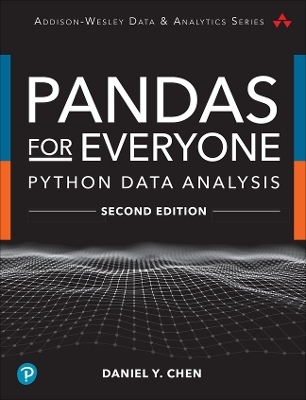
Pandas for Everyone
Addison Wesley (Verlag)
978-0-13-789115-3 (ISBN)
Today, analysts must manage data characterized by extraordinary variety, velocity, and volume. Using the open source Pandas library, you can use Python to rapidly automate and perform virtually any data analysis task, no matter how large or complex. Pandas can help you ensure the veracity of your data, visualize it for effective decision-making, and reliably reproduce analyses across multiple data sets.
Pandas for Everyone, 2nd Edition, brings together practical knowledge and insight for solving real problems with Pandas, even if you’re new to Python data analysis. Daniel Y. Chen introduces key concepts through simple but practical examples, incrementally building on them to solve more difficult, real-world data science problems such as using regularization to prevent data overfitting, or when to use unsupervised machine learning methods to find the underlying structure in a data set.
New features to the second edition include:
Extended coverage of plotting and the seaborn data visualization library
Expanded examples and resources
Updated Python 3.9 code and packages coverage, including statsmodels and scikit-learn libraries
Online bonus material on geopandas, Dask, and creating interactive graphics with Altair
Chen gives you a jumpstart on using Pandas with a realistic data set and covers combining data sets, handling missing data, and structuring data sets for easier analysis and visualization. He demonstrates powerful data cleaning techniques, from basic string manipulation to applying functions simultaneously across dataframes.
Once your data is ready, Chen guides you through fitting models for prediction, clustering, inference, and exploration. He provides tips on performance and scalability and introduces you to the wider Python data analysis ecosystem.
Work with DataFrames and Series, and import or export data
Create plots with matplotlib, seaborn, and pandas
Combine data sets and handle missing data
Reshape, tidy, and clean data sets so they’re easier to work with
Convert data types and manipulate text strings
Apply functions to scale data manipulations
Aggregate, transform, and filter large data sets with groupby
Leverage Pandas’ advanced date and time capabilities
Fit linear models using statsmodels and scikit-learn libraries
Use generalized linear modeling to fit models with different response variables
Compare multiple models to select the “best” one
Regularize to overcome overfitting and improve performance
Use clustering in unsupervised machine learning
Daniel Chen is a graduate student in the Interdisciplinary PhD program in Genetics, Bioinformatics & Computational Biology (GBCB) at Virginia Polytechnic Institute and State University (Virginia Tech). He is involved with Software Carpentry as an instructor, Mentoring Committee Member, and currently serves as the Assessment Committee Chair. He completed his Masters in Public Health at Columbia University Mailman School of Public Health in Epidemiology with a certificate in Advanced Epidemiology and currently extending his Master's thesis work in the Social and Decision Analytics Laboratory under the Virginia Bioinformatics Institute on attitude diffusion in social networks.
Foreword by Anne M. Brown xxiii
Foreword by Jared Lander xxv
Preface xxvii
Changes in the Second Edition xxxix
Part I: Introduction 1
Chapter 1. Pandas DataFrame Basics 3
Learning Objectives 3
1.1 Introduction 3
1.2 Load Your First Data Set 4
1.3 Look at Columns, Rows, and Cells 6
1.4 Grouped and Aggregated Calculations 23
1.5 Basic Plot 27
Conclusion 28
Chapter 2. Pandas Data Structures Basics 31
Learning Objectives 31
2.1 Create Your Own Data 31
2.2 The Series 33
2.3 The DataFrame 42
2.4 Making Changes to Series and DataFrames 45
2.5 Exporting and Importing Data 52
Conclusion 63
Chapter 3. Plotting Basics 65
Learning Objectives 65
3.1 Why Visualize Data? 65
3.2 Matplotlib Basics 66
3.3 Statistical Graphics Using matplotlib 72
3.4 Seaborn 78
3.5 Pandas Plotting Method 111
Conclusion 115
Chapter 4. Tidy Data 117
Learning Objectives 117
Note About This Chapter 117
4.1 Columns Contain Values, Not Variables 118
4.2 Columns Contain Multiple Variables 122
4.3 Variables in Both Rows and Columns 126
Conclusion 129
Chapter 5. Apply Functions 131
Learning Objectives 131
Note About This Chapter 131
5.1 Primer on Functions 131
5.2 Apply (Basics) 133
5.3 Vectorized Functions 138
5.4 Lambda Functions (Anonymous Functions) 141
Conclusion 142
Part II: Data Processing 143
Chapter 6. Data Assembly 145
Learning Objectives 145
6.1 Combine Data Sets 145
6.2 Concatenation 146
6.3 Observational Units Across Multiple Tables 154
6.4 Merge Multiple Data Sets 160
Conclusion 167
Chapter 7. Data Normalization 169
Learning Objectives 169
7.1 Multiple Observational Units in a Table (Normalization) 169
Conclusion 173
Chapter 8. Groupby Operations: Split-Apply-Combine 175
Learning Objectives 175
8.1 Aggregate 176
8.2 Transform 184
8.3 Filter 188
8.4 The pandas.core.groupby.DataFrameGroupBy object 190
8.5 Working with a MultiIndex 195
Conclusion 199
Part III: Data Types 203
Chapter 9. Missing Data 203
Learning Objectives 203
9.1 What Is a NaN Value? 203
9.2 Where Do Missing Values Come From? 205
9.3 Working with Missing Data 210
9.4 Pandas Built-In NA Missing 216
Conclusion 218
Chapter 10. Data Types 219
Learning Objectives 219
10.1 Data Types 219
10.2 Converting Types 220
10.3 Categorical Data 225
Conclusion 227
Chapter 11. Strings and Text Data 229
Introduction 229
Learning Objectives 229
11.1 Strings 229
11.2 String Methods 233
11.3 More String Methods 234
11.4 String Formatting (F-Strings) 236
11.5 Regular Expressions (RegEx) 239
11.6 The regex Library 247
Conclusion 247
Chapter 12. Dates and Times 249
Learning Objectives 249
12.1 Python's datetime Object 249
12.2 Converting to datetime 250
12.3 Loading Data That Include Dates 253
12.4 Extracting Date Components 254
12.5 Date Calculations and Timedeltas 257
12.6 Datetime Methods 259
12.7 Getting Stock Data 261
12.8 Subsetting Data Based on Dates 263
12.9 Date Ranges 266
12.10 Shifting Values 270
12.11 Resampling 276
12.12 Time Zones 278
12.13 Arrow for Better Dates and Times 280
Conclusion 280
Part IV: Data Modeling 281
Chapter 13. Linear Regression (Continuous Outcome Variable) 283
13.1 Simple Linear Regression 283
13.2 Multiple Regression 287
13.3 Models with Categorical Variables 289
13.4 One-Hot Encoding in scikit-learn with Transformer Pipelines 294
Conclusion 296
Chapter 14. Generalized Linear Models 297
About This Chapter 297
14.1 Logistic Regression (Binary Outcome Variable) 297
14.2 Poisson Regression (Count Outcome Variable) 304
14.3 More Generalized Linear Models 308
Conclusion 309
Chapter 15. Survival Analysis 311
15.1 Survival Data 311
15.2 Kaplan Meier Curves 312
15.3 Cox Proportional Hazard Model 314
Conclusion 317
Chapter 16. Model Diagnostics 319
16.1 Residuals 319
16.2 Comparing Multiple Models 324
16.3 k-Fold Cross-Validation 329
Conclusion 334
Chapter 17. Regularization 335
17.1 Why Regularize? 335
17.2 LASSO Regression 337
17.3 Ridge Regression 338
17.4 Elastic Net 340
17.5 Cross-Validation 341
Conclusion 343
Chapter 18. Clustering 345
18.1 k-Means 345
18.2 Hierarchical Clustering 351
Conclusion 356
Part V. Conclusion 357
Chapter 19. Life Outside of Pandas 359
19.1 The (Scientific) Computing Stack 359
19.2 Performance 360
19.3 Dask 360
19.4 Siuba 360
19.5 Ibis 361
19.6 Polars 361
19.7 PyJanitor 361
19.8 Pandera 361
19.9 Machine Learning 361
19.10 Publishing 362
19.11 Dashboards 362
Conclusion 362
Chapter 20. It's Dangerous To Go Alone! 363
20.1 Local Meetups 363
20.2 Conferences 363
20.3 The Carpentries 364
20.4 Podcasts 364
20.5 Other Resources 365
Conclusion 365
Appendices 367
A. Concept Maps 369
B. Installation and Setup 373
C. Command Line 377
D. Project Templates 379
E. Using Python 381
F. Working Directories 383
G. Environments 385
H. Install Packages 389
I. Importing Libraries 391
J. Code Style 393
K. Containers: Lists, Tuples, and Dictionaries 395
L. Slice Values 399
M. Loops 401
N. Comprehensions 403
O. Functions 405
P. Ranges and Generators 409
Q. Multiple Assignment 413
R. Numpy ndarray 415
S. Classes 417
T. SettingWithCopyWarning 419
U. Method Chaining 423
V. Timing Code 427
W. String Formatting 429
X. Conditionals (if-elif-else) 433
Y. New York ACS Logistic Regression Example 435
Z. Replicating Results in R 443
Index 451
| Erscheinungsdatum | 05.01.2023 |
|---|---|
| Reihe/Serie | Addison-Wesley Data & Analytics Series |
| Verlagsort | Boston |
| Sprache | englisch |
| Maße | 178 x 232 mm |
| Gewicht | 801 g |
| Themenwelt | Informatik ► Datenbanken ► Data Warehouse / Data Mining |
| ISBN-10 | 0-13-789115-6 / 0137891156 |
| ISBN-13 | 978-0-13-789115-3 / 9780137891153 |
| Zustand | Neuware |
| Informationen gemäß Produktsicherheitsverordnung (GPSR) | |
| Haben Sie eine Frage zum Produkt? |
aus dem Bereich


